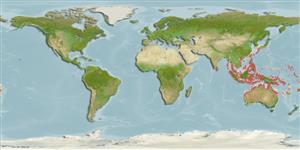Common names from other countries
Environment: milieu / climate zone / depth range / distribution range
Ecologia
; intervalo de profundidade 0 - 5 m (Ref. 101210). Tropical
Indo-West Pacific.
Length at first maturity / Tamanho / Peso / Idade
Maturity: Lm ? range ? - ? cm Max length : 7.0 cm ShH macho/indeterminado; (Ref. 349); common length : 5.0 cm SHL macho/indeterminado; (Ref. 349)
Shell pyramidal with angular body whorl and flat base. Exterior highly sculptured with thick, rounded oblique ribs, at least on the lower half of each whorl (Ref. 128042).
Locally collected for food (Refs. 349, 128042).
Life cycle and mating behavior
Maturidade | Reprodução | Desova | Ovos | Fecundidade | Larvas
Members of the order Archaeogastropoda are mostly gonochoric and broadcast spawners. Life cycle: Embryos develop into planktonic trocophore larvae and later into juvenile veligers before becoming fully grown adults.
Poutiers, J.M. 1998. (Ref. 349)
Status na Lista Vermelha da IUCN (Ref. 130435: Version 2024-1)
Status no CITES (Ref. 108899)
Not Evaluated
Not Evaluated
Perigo para os humanos
Harmless
Uso pelos humanos
| FishSource |
Ferramentas
Fontes da internet
Estimates based on models
Preferred temperature
(Ref.
115969): 25 - 29.3, mean 28.6 (based on 2270 cells).
Vulnerabilidade
Low vulnerability (10 of 100).
Categoria de preço
Unknown.
